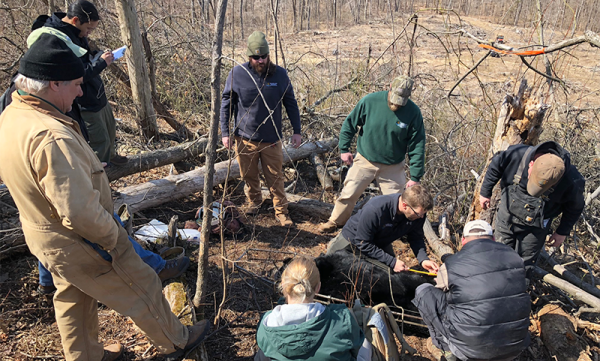Today, I wrestled a bear.
It wasn’t big, just five pounds. Still, it had claws and a whole lot of attitude.
I joined the U.S. Fish and Wildlife Service’s Tom Decker, a wildlife biologist for the Service’s Wildlife and Sport Fishing Restoration program, and Harry Spiker of the Maryland Department of Natural Resources Wildlife & Heritage Service, for a bear den study. Both were proud of the population of black bear in western Maryland.
Just about 40 years ago Maryland listed black bears as a state endangered species because populations dwindled low due to encroachment and habitat loss. By 1985, bears recovered enough they were again listed as a game species and in 2004, the state held its first bear hunt in 51 years.
Black bears are now found in Maryland’s four western counties, more than 2,000 at the state’s last population estimate, with sightings across the state. It’s a “recolonization” success story as bears reclaim the habitat they once roamed. It’s also verification of how the firearms and ammunition industry has helped North American wildlife recover to some of the healthiest levels on record.
Excise Tax for Conservation
It sounds counterintuitive, right? More guns and ammunition should seem like a threat to wildlife, but the exact opposite is true. It’s all because of the Federal Aid in Wildlife Restoration Act, which enabled the Pittman-Robertson excise tax, which is paid by firearms and ammunition manufacturers on the production of each gun and bullet or shotshell. It’s been in place since 1937, when manufacturers stepped forward to partner with federal authorities to provide funds for the recovery of wildlife populations from then critically-low levels.
Since the fund was started, $12 billion has been raised. These funds paid for the conservation programs that preserved and restored habitat and made possible study, breeding and relocation programs. Let’s put this into perspective. At the turn of the century, there were few ducks in the marshes, less than a half million whitetail deer, about 100,000 wild turkey and only 41,000 Rocky Mountain elk. Today, 46 million ducks migrate through our skies, 32 million deer are in our woods and fields, 7 million wild turkey roam and more than a million elk move through their ranges.
Black bear numbers fell as low as 200,000 across North America. Today, that number is 800,000, with nearly a half a million in the continental United States.
Into the Bear’s Den
All this made it important for me to join Decker and Spiker. The area they took a small group, including me, into was an open pocket of young forest created for wildlife two years ago using Pittman-Robertson Funds. Also paid by the same funds were the sedative drugs, radio collars, tracking chips and telemetry gear to locate the bears. The taxes paid by the gun and ammo makers are literally paying for the sustainment of Maryland’s bears.

Spiker and his team of biologists darted the sow and pulled out four healthy three-to-four-week old cubs. Each was about the size of a small puppy, and just as inquisitive. Within weeks, they won’t be so easily held and will be keeping their mother busy. For the next two years, in fact, she’ll keep these cubs close.
Black bear can live for as long as 25 years. Spiker said he tracked one sow for more than 16 years, and she birthed 25 cubs in that time. She did her part to grow the bear population.
Firearms Industry Wants to Do More
The National Shooting Sports Foundation® represents an industry that wants to do its part, funding more of these types of programs using Pittman-Robertson funds. That’s why we’ve thrown our support behind the Target Practice and Marksmanship Training Support Act, S. 94 in the U.S Senate and H.R. 1222 in the U.S. House of Representatives. This legislation would allow states more flexibility to use the same funds to build and improve existing public recreational shooting ranges. Today’s gun owners are looking for more places to target shoot and having more places to shoot will allow them to purchase and use more firearms and ammunition, which, in turn, funds more conservation.
I’d love to tell you I won the wrestling match with the cub. She got the best of me. True to form, she’s a climber, making her way to the top of my head. I left her with her three siblings and the sow. She left me with a couple of scratches and the first-hand knowledge that firearms and ammunition makers are making sure that future generations of bears will roam these hills for decades to come.

— Mark Oliva
This field day was part of a larger national initiative entitled “Partner with a Payer” in which the NSSF and USFWS have teamed up with state wildlife agencies to showcase localized examples of how excise taxes on firearms and ammunition are being used in conservation to improve wildlife habitat and populations as well as improving hunting and target shooting opportunities. Manufacturers of excise tax products that are interested in getting out in the field with their state wildlife agency can contact Jim Curcuruto, NSSF director of research and market development at jcurcuruto@nssf.org or 203-426-1320 x234.